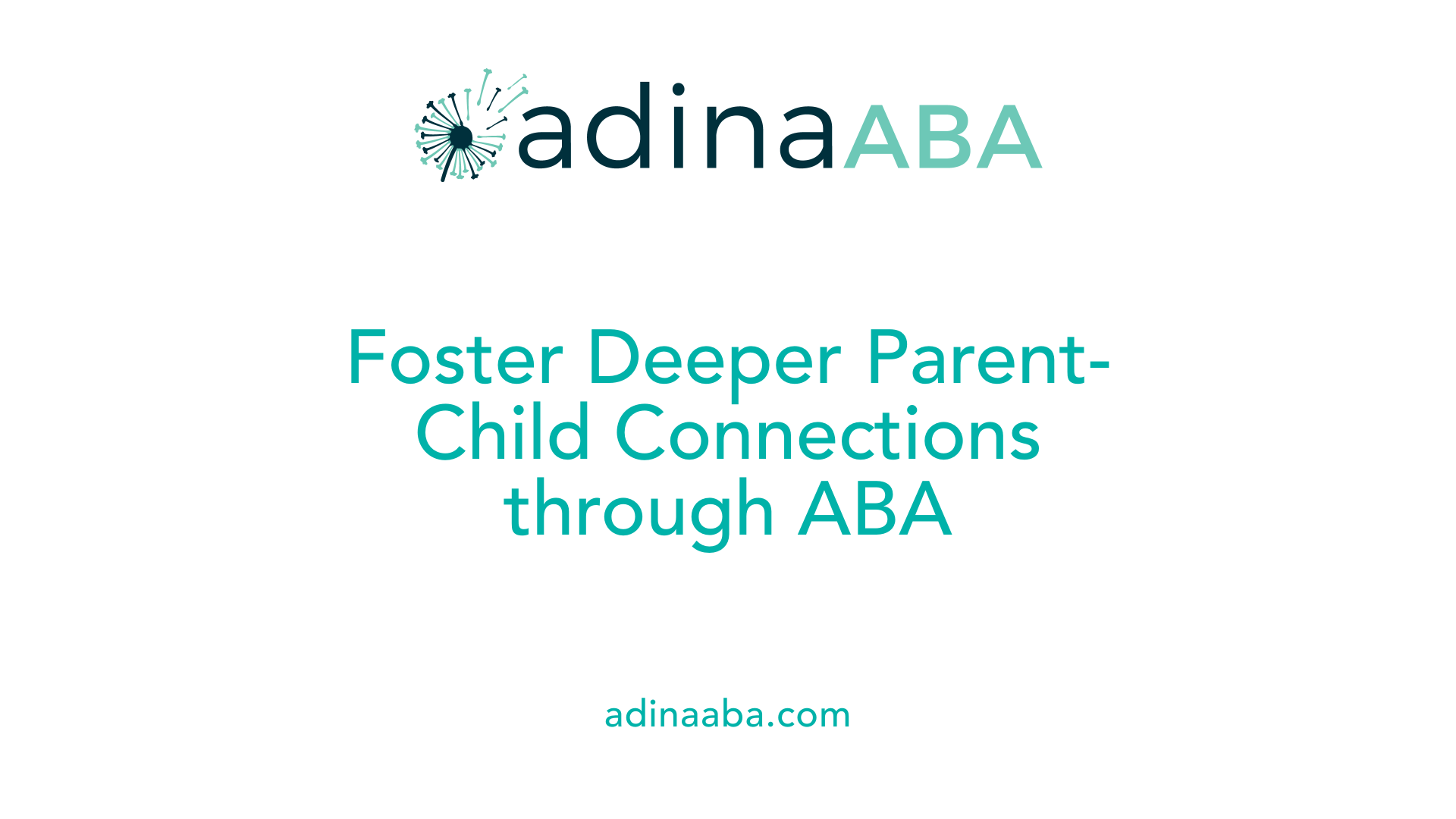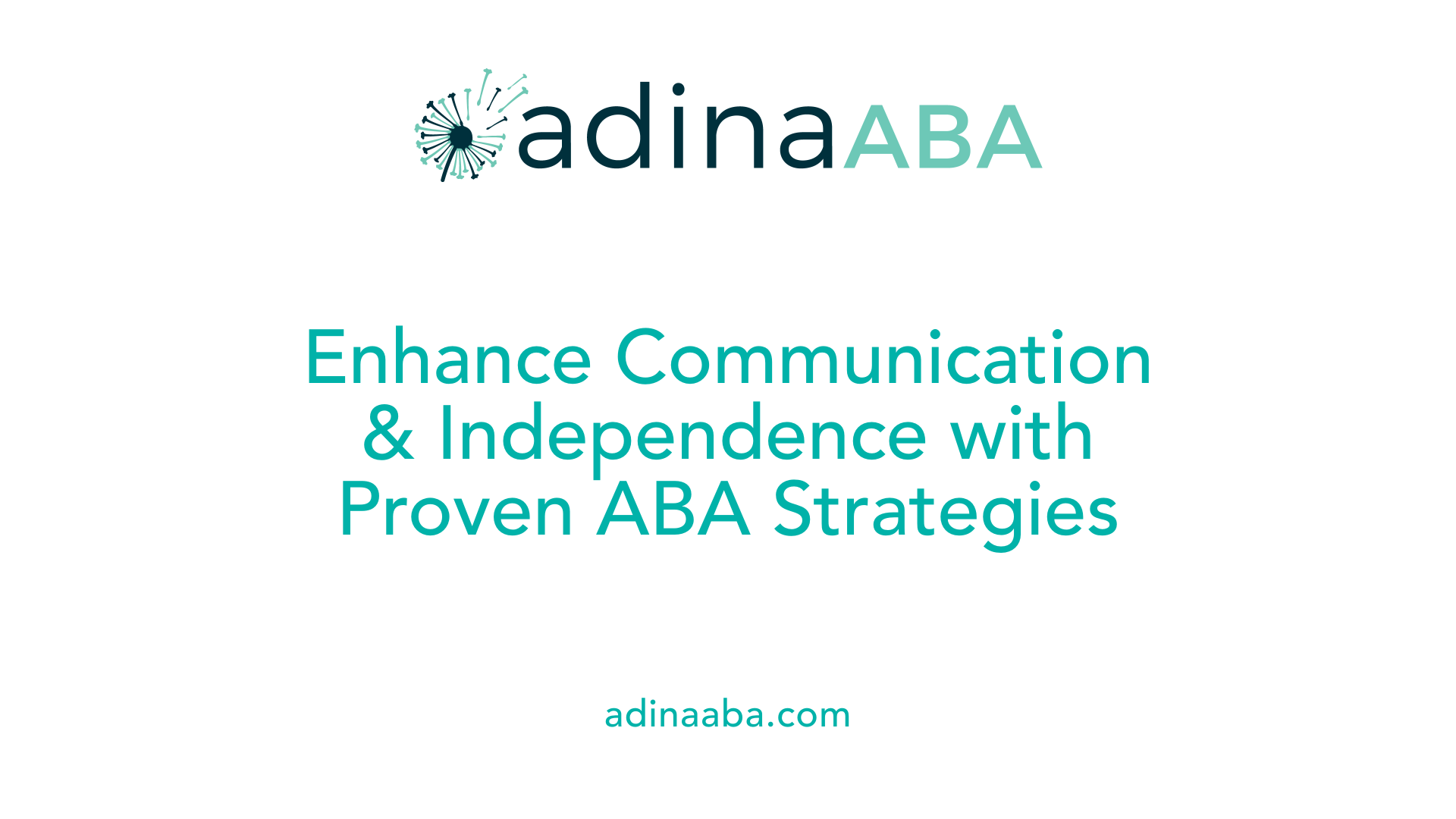How ABA Therapy Strengthens Parent-Child Communication

Understanding the Impact of ABA on Family Communication
Applied Behavior Analysis (ABA) therapy is a proven, evidence-based intervention widely recognized for its effectiveness in supporting children with autism. Beyond individual skill acquisition, ABA plays a crucial role in strengthening the emotional and communicative bonds within families. This article explores how ABA improves parent-child communication, enhances family interactions, and transforms relationship dynamics, ultimately fostering a supportive environment where children can thrive both socially and emotionally.
Personalized Strategies for Enhancing Communication

How can ABA therapy improve parent-child communication?
ABA therapy is highly effective in strengthening communication between parents and children with autism. It focuses on teaching children functional communication skills tailored specifically to their needs, using proven strategies like positive reinforcement, modeling, and prompting. This approach encourages children to express themselves more clearly and interact meaningfully.
Active parent involvement is crucial. ABA therapists work hand-in-hand with parents, providing practical guidance and training to reinforce communication skills at home. Consistent application of these strategies across daily routines fosters better understanding and trust within the family.
Effective communication is further promoted through ongoing updates and empathetic listening by therapists, which helps build a strong, collaborative relationship. When parents are involved directly in the therapy process, they gain deeper insight and confidence, making it easier to support their child's growth.
In-home therapy sessions enhance this connection by integrating strategies into everyday activities, fostering empathy and shared understanding. Overall, ABA creates a positive, structured environment that nurtures meaningful exchanges, improving social interactions and behavioral development within the family.
What methods and strategies are used in ABA therapy to enhance communication skills?
ABA therapy employs a broad spectrum of evidence-based techniques to boost communication. These include positive reinforcement, where desired behaviors are rewarded to encourage repetition, and prompting, where guidance is provided to initiate communication acts.
Modeling and imitation are foundational, helping children learn appropriate ways to express or respond. These methods are often complemented with fading techniques, gradually reducing prompts as skills become more autonomous.
The therapy also uses structured approaches like Discrete Trial Training (DTT), which involves repeated practice in controlled settings, and Natural Environment Teaching (NET), which integrates learning into everyday situations.
In addition, ABA incorporates various communication tools such as Picture Exchange Communication Systems (PECS), speech-generating devices, sign language, and communication boards. These augmentative and alternative communication (AAC) systems support expressive and receptive language development.
By customizing interventions to the child's needs, ABA therapy ensures effective learning. The combination of behavioral techniques and communication aids helps children improve their ability to understand social cues, develop vocabulary, and express their needs more clearly.
| Technique | Description | Application in Therapy |
|---|---|---|
| Positive Reinforcement | Reward for desired behavior to encourage it again | Verbal praise, preferred toys, or activities |
| Prompting | Guidance to initiate or complete communication actions | Verbal prompts, gestures, or physical guidance |
| Fading | Gradually removing prompts as skills improve | Transitioning from physical to verbal prompts |
| Modeling | Demonstrating correct behavior for imitation | Therapist or parent demonstrating communication behaviors |
| Discrete Trial Training | Structured, repeated practice in a controlled setting | Using clear cues and immediate reinforcement |
| Natural Environment Teaching | Incorporating learning into daily activities | Practicing communication during mealtime, play, or routine tasks |
| AAC Tools | Devices or visuals to support communication | PECS, speech-generating devices, sign language |
Staying informed about research and refining techniques help parents and therapists work together effectively. Building on these strategies, ABA therapy continues to develop innovative ways to support each child's unique communication journey.
The Power of Parental Engagement in Therapy

How does parental involvement impact the effectiveness of ABA therapy in improving communication?
Parental involvement plays a critical role in enhancing the success of ABA therapy, especially in improving communication skills. When parents actively participate, they provide consistent reinforcement of what the child learns during therapy sessions, which helps solidify new skills. Continuity across different settings ensures that children can transfer and generalize these skills to everyday situations.
Engaged parents collaborate closely with therapists, which leads to tailored strategies that meet their child's specific needs. This cooperation fosters a supportive environment that encourages the child to practice communication skills more confidently.
Training and education are vital, empowering parents to correctly implement techniques such as modeling, prompting, and positive reinforcement. Being well-informed and confident in these strategies results in more consistent application, which boosts the child's motivation and progress.
Effective communication between parents and therapists, built on understanding and trust, ensures that goals are clear and strategies are adaptable. This partnership promotes a cohesive approach, maximizing the child's therapeutic outcomes.
In summary, informed and involved parents help create a nurturing environment where children can develop better communication, promoting lifelong skills that extend beyond therapy sessions.
What benefits do families experience when they actively participate in ABA therapy?
Families that engage actively in ABA therapy see numerous benefits that extend beyond the child's immediate development. One of the most notable improvements is stronger, more positive family interactions. Regular participation equips parents and caregivers with tools to communicate effectively, exhibit patience, and understand their child's unique behaviors better.
Involvement ensures that therapy strategies are consistently applied at home, allowing skills learned in sessions to be reinforced in natural settings. This consistency accelerates skill acquisition and helps children apply their new behaviors in real-world situations.
Active family participation also fosters a more collaborative environment. Families can tailor interventions based on their insights, making the therapy more relevant and effective. It reduces family stress by providing a sense of control and contribution.
Moreover, implementing these strategies enhances family cohesion, as members work toward shared goals. It builds empathy and resilience within the family unit, supporting healthier relationships.
Overall, families that participate actively in ABA therapy report increased confidence, improved communication, and a greater sense of achievement in supporting their child's growth. This involvement not only benefits the child but also strengthens familial bonds and creates a more supportive home environment.
Strengthening Bonds Through Emotional and Behavioral Growth

What is the impact of ABA therapy on the relationship dynamics between parents and children?
ABA therapy can greatly improve the relationship dynamics between parents and children by promoting closer and more understanding connections. This form of therapy often involves parents directly, especially in in-home settings, allowing them to observe, participate, and reinforce learned strategies.
By being actively involved, parents can better understand their child's behaviors, needs, and progress. This continuous engagement fosters empathy and patience, which are essential for a healthy relationship.
The collaborative relationship that develops between parents and therapists builds mutual trust, making it easier to set shared goals and work together effectively. Communication becomes more open, and parents feel more confident in supporting their child's development.
Celebrating small successes and establishing routines together also strengthen emotional bonds. When parents see improvements and feel empowered by their ability to contribute, the sense of partnership deepens. Overall, ABA therapy nurtures a nurturing, trusting, and cooperative family environment where emotional connections thrive.
How can ABA therapy foster a supportive and trusting family environment?
Active parental involvement in ABA therapy plays a crucial role in creating a positive and supportive family atmosphere. When parents are trained to implement ABA strategies, they gain confidence, which reduces frustration and promotes more effective communication.
Regular interactions with therapists through feedback sessions and consultations ensure that parents feel supported and that their insights are valued. This ongoing collaboration helps parents understand their child's unique needs and adapt strategies accordingly.
As children start demonstrating better communication, social, and self-care skills, family interactions tend to become more harmonious. This improvement reduces conflicts and promotes understanding and patience.
A family environment built on trust and collaboration encourages emotional security. When everyone feels heard and understood, the family unit becomes more resilient and supportive of one another.
Moreover, seeing positive changes in the child's behavior reassures family members, fostering ongoing engagement and reinforcing a trusting atmosphere. The result is a stronger emotional bond, rooted in shared effort, understanding, and respect.
| Aspect | Description | Impact on Family Environment |
|---|---|---|
| Parental Training | Teaching parents ABA strategies | Increased confidence and competence |
| Open Communication | Regular feedback & collaboration | Better understanding & less frustration |
| Child Progress | Improved social and communication skills | Reduced conflicts, more harmony |
| Routine & Celebrations | Establishing routines & acknowledging small wins | Strengthened bonds & emotional security |
| Overall Effect | Partnership fosters trust | Foundation for resilient family bonds |
Building emotional bonds
Effective ABA therapy enhances emotional bonds by helping children communicate their needs and feelings better. Techniques like modeling, role-playing, and reinforcement encourage children to express themselves, which deepens parent-child understanding.
Fostering social skills such as taking turns, sharing, and making eye contact through structured activities can be transferred into daily interactions, enriching the emotional fabric of the family.
Parents' active participation, coupled with consistent reinforcement, not only supports skill acquisition but also reinforces a sense of security and love in the family. This shared journey fosters empathy and mutual respect, laying the groundwork for lasting emotional bonds.
In summary, ABA therapy's success in strengthening relationships lies in creating a collaborative and empowering environment. This approach helps families grow closer, trust each other more, and build a resilient support system centered around their child's development.
Strategies for Developing Child’s Communication and Independence

How does ABA therapy support child development through improved communication?
ABA therapy plays a vital role in helping children with autism improve their communication skills. It creates personalized plans that focus on both expressive language—like speaking and gestures—and receptive skills, such as understanding instructions. Techniques such as Verbal Behavior Therapy, modeling, prompting, and natural environment teaching are used to teach children how to communicate effectively.
Positive reinforcement is an essential part of ABA, encouraging children to use their new communication skills by rewarding desired behaviors. When children successfully express their needs or respond to questions, they are praised or rewarded, which helps them repeat these behaviors over time.
The therapy also emphasizes recognizing and responding to social cues, such as eye contact and body language. It often incorporates augmentative and alternative communication (AAC) tools like picture exchange systems, speech-generating devices, or sign language, providing additional ways for children to express themselves.
Overall, ABA’s structured and evidence-based strategies significantly enhance a child's ability to communicate, leading to better social interactions, independence, and confidence.
Ensuring Long-Term Success and Skill Generalization

How important is practicing skills in real-world situations?
Practicing skills in everyday settings is crucial for children to transfer what they learn during therapy into their daily lives. ABA programs emphasize real-world application, allowing children to practice social interactions, self-care routines, and communication in environments such as home, school, and community settings.
This practical approach helps children develop confidence and independence, ensuring that behaviors and skills are retained beyond structured therapy sessions. Techniques like role-playing and modeling are used to simulate real-life situations, making skills relevant and easier to generalize.
How does family involvement in routines enhance therapy outcomes?
Families play a vital role in reinforcing skills learned during ABA therapy through daily routines. Incorporating therapy strategies into routines such as mealtime, dressing, and social interactions creates consistent learning opportunities.
Family involvement helps children apply new skills naturally and comfortably, leading to better retention and generalization. Parents and caregivers who are trained in ABA techniques can consistently implement positive reinforcement, behavior management, and environmental modifications at home.
This ongoing support fosters a cohesive environment where the child's progress is supported across all settings, strengthening their overall development.
Why are ongoing therapy and necessary adjustments important?
ABA therapy is most effective when it evolves with the child's growth and changing needs. Regular assessment and adjustment of the therapy plan ensure the continued relevance and challenge of goals.
Ongoing therapy allows for tackling new challenges as they arise, fostering continuous skill development. It also provides opportunities to incorporate the child's interests and preferences, maintaining motivation.
Furthermore, as children develop, their abilities to learn and generalize skills improve. Therapists and families working together can adapt strategies, incorporate new techniques, and set new milestones, resulting in sustained progress.
How does celebrating small successes motivate children?
Recognizing and celebrating small accomplishments boosts a child's confidence and motivation. Reinforcing even minor progress encourages children to engage actively in learning new skills and behaviors.
Celebrations such as praise, rewards, or special activities help children see their efforts as valuable, fostering a positive attitude toward therapy and daily routines. This motivation promotes resilience and perseverance, especially when facing difficult tasks.
In summary, integrating practice in real-world settings, involving family routines, maintaining ongoing, adaptable therapy, and celebrating small successes collectively contribute to meaningful and lasting progress in children undergoing ABA therapy.
| Aspect | Description | Examples |
|---|---|---|
| Practice in real-world settings | Promotes skill transfer and independence in daily environments | Grocery shopping, social outings, self-care routines |
| Family involvement in routines | Reinforces skills through consistent application at home | Meal times, bedtime, social play |
| Ongoing therapy and adjustments | Ensures therapy remains relevant and effective over time | Regular assessments, goal updates, personalized strategies |
| Celebrating small successes | Builds confidence and motivation for continued learning | Verbal praise, stickers, extra playtime |
By actively practicing skills across various settings and involving families in daily routines, children can better generalize their learned behaviors. Continuous therapy with flexible strategies ensures sustained development, while celebrating achievements keeps children motivated to reach new milestones.
Enhancing Child Development and Preparing for Adulthood
What methods and strategies are used in ABA therapy to enhance communication skills?
ABA therapy employs various research-backed methods to improve communication in children with autism. Central to these are positive reinforcement and structured teaching approaches. Techniques such as prompting, where therapists guide children toward desired responses, and fading, which gradually reduces assistance, are commonly used.
Modeling and imitation help children mimic appropriate sounds, words, and social behaviors. In addition, ABA incorporates specific language strategies like teaching mands (requests), tacts (labels), and intraverbals (conversational responses) to build functional communication.
To support expressive and receptive language, many programs integrate Augmentative and Alternative Communication (AAC) tools. These include picture exchange systems (PECS), speech-generating devices, sign language, and communication boards, allowing children to express themselves effectively.
Structured methods such as Discrete Trial Training (DTT) break skills into manageable steps, teaching them systematically. Natural Environment Teaching (NET) encourages learning in everyday settings, making skills more versatile and applicable.
Overall, ABA therapy personalizes interventions to meet each child's evolving needs, integrating traditional techniques with AAC tools to foster comprehensive language development.
Fostering Lasting Connections for a Stronger Family Bond
ABA therapy is a powerful tool that not only supports individual child development but also plays a vital role in strengthening familial bonds and enhancing parent-child communication. By actively involving parents in the therapy process, offering tailored strategies, and emphasizing consistent, supportive interactions, ABA helps foster a nurturing environment rooted in trust and understanding. Over time, the skills learned through ABA translate into more meaningful family interactions, greater emotional security, and a cohesive unit working together towards shared goals. Ultimately, effective ABA strategies empower families to build resilient, supportive relationships that lay the foundation for lifelong success.
References
- What is ABA Therapy? A Guide for Parents
- The Crucial Role of Parent Training in ABA
- Benefits of ABA Therapy for Children with Autism
- Should Parents Stay During ABA Therapy Sessions?
- The Role of Family in ABA Therapy: Tips for Parents
- What Are the Top Benefits of ABA Therapy?
- The Role of Parent Involvement in ABA Therapy - Radical Minds
- Part 9: Importance of Family Involvement in ABA Therapy
More Resources
Expert Clinicians
Get started today ->



.jpg)


.jpg)